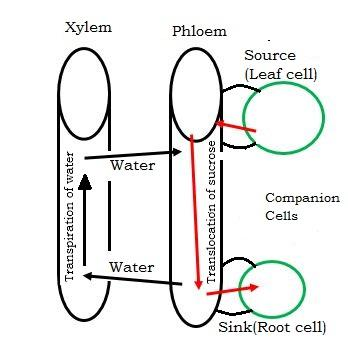
Describe the mass flow hypothesis for the transportation of organic solutes (food) in plants.
Answer
557.1k+ views
Hint: The minerals and water have to be transported in all the parts of the plants through xylem. Similarly, the food materials synthesized in the leaves are to be conducted and distributed in all the parts through phloem. Several theories have been put to determine the mechanism of conduction. Mass flow hypothesis was put forward to explain transport via the phloem. This is the same as the pressure-flow hypothesis.
Complete step-by-step answer:

The mass flow or pressure flow hypothesis was suggested by German scientist Ernst Münch in 1930. It was proposed to explain the movement of food in plants via the phloem. The movement of water through Xylem is unidirectional and can be explained relatively simply. But the Phloem movement is bidirectional. To explain the movement through the phloem, this hypothesis takes the help of xylem water flow to create a diffusion gradient.
To put it simply, inside cells of the phloem at a source (leaf) will have a high concentration of sugar (which is usually the food produced). This creates an osmotic gradient that draws water into the cells from the adjacent xylem. This creates turgor pressure in the phloem. This drives the movement of phloem sap via mass flow from sugar sources to sugar sinks. The whole process can be divided into six steps as mentioned below :
> Water absorption occurs from nearby cells. This increases hydrostatic pressure in the source.
> Phloem will load transfer of food from the source to the sieve tubes of the phloem.
> The gradient created by this will facilitate water entry from xylem to sieve tubes (osmosis).
> The resultant hydrostatic pressure differences drive the food from the sieve-tube to sink.
> At the sink, phloem unloads the food from sieve-tube to sink.
> After this, water moves back to xylem vessels by osmosis.
Note: It is an interesting fact that the xylem water transport plays a major role in phloem transport. Xylem movement is explained by the Adhesion tension transpiration pull model. The movement is unidirectional because of this pull. During the movement of solutes through phloem, the source is referred to leaves where sugars and other organic molecules synthesized and sink is the term given to all other cells where these materials are delivered and utilized.
Complete step-by-step answer:

The mass flow or pressure flow hypothesis was suggested by German scientist Ernst Münch in 1930. It was proposed to explain the movement of food in plants via the phloem. The movement of water through Xylem is unidirectional and can be explained relatively simply. But the Phloem movement is bidirectional. To explain the movement through the phloem, this hypothesis takes the help of xylem water flow to create a diffusion gradient.
To put it simply, inside cells of the phloem at a source (leaf) will have a high concentration of sugar (which is usually the food produced). This creates an osmotic gradient that draws water into the cells from the adjacent xylem. This creates turgor pressure in the phloem. This drives the movement of phloem sap via mass flow from sugar sources to sugar sinks. The whole process can be divided into six steps as mentioned below :
> Water absorption occurs from nearby cells. This increases hydrostatic pressure in the source.
> Phloem will load transfer of food from the source to the sieve tubes of the phloem.
> The gradient created by this will facilitate water entry from xylem to sieve tubes (osmosis).
> The resultant hydrostatic pressure differences drive the food from the sieve-tube to sink.
> At the sink, phloem unloads the food from sieve-tube to sink.
> After this, water moves back to xylem vessels by osmosis.
Note: It is an interesting fact that the xylem water transport plays a major role in phloem transport. Xylem movement is explained by the Adhesion tension transpiration pull model. The movement is unidirectional because of this pull. During the movement of solutes through phloem, the source is referred to leaves where sugars and other organic molecules synthesized and sink is the term given to all other cells where these materials are delivered and utilized.
Recently Updated Pages
The number of solutions in x in 02pi for which sqrt class 12 maths CBSE

Write any two methods of preparation of phenol Give class 12 chemistry CBSE

Differentiate between action potential and resting class 12 biology CBSE

Two plane mirrors arranged at right angles to each class 12 physics CBSE

Which of the following molecules is are chiral A I class 12 chemistry CBSE

Name different types of neurons and give one function class 12 biology CBSE

Trending doubts
One Metric ton is equal to kg A 10000 B 1000 C 100 class 11 physics CBSE

What is 1s 2s 2p 3s 3p class 11 chemistry CBSE

Discuss the various forms of bacteria class 11 biology CBSE

State the laws of reflection of light

Explain zero factorial class 11 maths CBSE

An example of chemosynthetic bacteria is A E coli B class 11 biology CBSE




